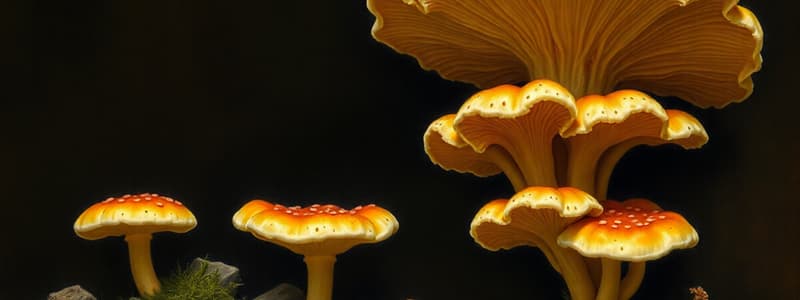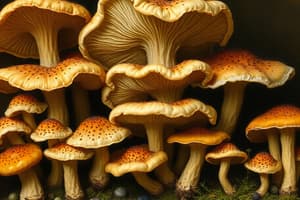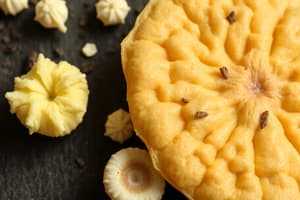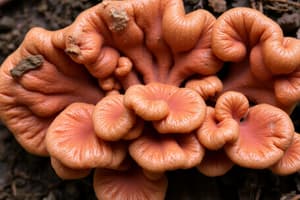Podcast
Questions and Answers
What is the primary method by which yeasts reproduce?
What is the primary method by which yeasts reproduce?
- Binary fission
- Fragmentation
- Budding (correct)
- Spore formation
Which of the following characteristics is true about moulds?
Which of the following characteristics is true about moulds?
- They typically grow in dry environments
- They have a fluffy appearance (correct)
- They are unicellular
- They can only reproduce sexually
What type of spores do moulds primarily produce?
What type of spores do moulds primarily produce?
- Both asexual and sexual spores (correct)
- Asexual spores only
- No spores at all
- Sexual spores only
What is the term used for the mass of hyphae that forms a mould colony?
What is the term used for the mass of hyphae that forms a mould colony?
Which of the following colours is NOT typically associated with moulds?
Which of the following colours is NOT typically associated with moulds?
In what type of conditions do moulds primarily grow?
In what type of conditions do moulds primarily grow?
Which fungus is commonly found on the skin as a fungal commensal?
Which fungus is commonly found on the skin as a fungal commensal?
What is the main health risk associated with mould exposure?
What is the main health risk associated with mould exposure?
Which of the following accurately describes the form of yeast?
Which of the following accurately describes the form of yeast?
What is the unique structural feature of yeast compared to mould?
What is the unique structural feature of yeast compared to mould?
In which of the following locations are yeasts typically found?
In which of the following locations are yeasts typically found?
What is true about the appearance of yeast?
What is true about the appearance of yeast?
Which characteristic differentiates yeasts from sporing fungi?
Which characteristic differentiates yeasts from sporing fungi?
Which of the following characteristics is unique to yeasts compared to moulds?
Which of the following characteristics is unique to yeasts compared to moulds?
What is the primary health risk associated with an overgrowth of yeast fungi?
What is the primary health risk associated with an overgrowth of yeast fungi?
Which statement about the health risks of yeast is correct?
Which statement about the health risks of yeast is correct?
What distinguishes true hyphae from pseudo-hyphae in yeast?
What distinguishes true hyphae from pseudo-hyphae in yeast?
Which of the following is a common habitat for moulds?
Which of the following is a common habitat for moulds?
Which feature distinguishes moulds in terms of their cell organization?
Which feature distinguishes moulds in terms of their cell organization?
Which statement is true regarding the oxygen requirements of yeast?
Which statement is true regarding the oxygen requirements of yeast?
What type of organisms are included in the definition of commensal oral microflora?
What type of organisms are included in the definition of commensal oral microflora?
Which type of fungi does not possess true hyphae but instead forms pseudohyphae?
Which type of fungi does not possess true hyphae but instead forms pseudohyphae?
Which of the following colors is NOT commonly associated with moulds?
Which of the following colors is NOT commonly associated with moulds?
Which statement about yeast and oxygen requirements is true?
Which statement about yeast and oxygen requirements is true?
What is the primary impact of inhaling spores from cryptococcus?
What is the primary impact of inhaling spores from cryptococcus?
Which of the following fungi is associated with causing allergic reactions in the host?
Which of the following fungi is associated with causing allergic reactions in the host?
What is the common habitat for Zygomycota fungi?
What is the common habitat for Zygomycota fungi?
Which treatment is generally prescribed for cryptococcus infections?
Which treatment is generally prescribed for cryptococcus infections?
What is a significant transmission method for Aspergillus?
What is a significant transmission method for Aspergillus?
Which symptom is NOT typically associated with systemic fungal infections caused by cryptococcus?
Which symptom is NOT typically associated with systemic fungal infections caused by cryptococcus?
What is the correct pathogenicity pathway for Zygomycosis?
What is the correct pathogenicity pathway for Zygomycosis?
Which factor is NOT a risk associated with fungal infections?
Which factor is NOT a risk associated with fungal infections?
What primarily characterizes a mucosal candidiasis infection?
What primarily characterizes a mucosal candidiasis infection?
Which of the following is NOT a condition caused by Candida albicans?
Which of the following is NOT a condition caused by Candida albicans?
What is a common host predisposing factor for Candida infections?
What is a common host predisposing factor for Candida infections?
Which pathogenicity factor is associated with the infective process of Candida albicans?
Which pathogenicity factor is associated with the infective process of Candida albicans?
What type of candidiasis can result from candidemia?
What type of candidiasis can result from candidemia?
Which of the following conditions is specifically characterized by a bright red, shiny rash?
Which of the following conditions is specifically characterized by a bright red, shiny rash?
Which of these factors is NOT considered a predisposing factor to Candida infections?
Which of these factors is NOT considered a predisposing factor to Candida infections?
Cryptococcus neoformans is associated with which host predisposing factor?
Cryptococcus neoformans is associated with which host predisposing factor?
Flashcards are hidden until you start studying
Study Notes
Fungi: Yeast vs. Mould
- Fungi are eukaryotic organisms. Candida is a key fungus in dentistry.
- Fungi exist in two forms: yeast (single-celled) and mould (multicellular). Some fungi are dimorphic (both forms).
- Yeast cells are unicellular, commonly found on fruit, in the oral cavity, and vagina. They appear white and thready, oval-shaped. They don't have true hyphae, but form pseudohyphae. They reproduce by budding or binary fission. They can grow aerobically or anaerobically. Overgrowth can cause infections in immunocompromised individuals.
- Moulds are multicellular, growing as tubular branches (hyphae). Hyphae form a mycelium. They're typically found in damp, dark areas. They appear fuzzy and come in various colours. They reproduce via spores (asexual or sexual reproduction). They require oxygen to grow and can cause allergic reactions and respiratory problems.
Fungal Commensal Flora
- Fungi are part of the commensal flora on skin, in the mouth, and gut.
- Candida albicans is found on the skin.
- Malassezia is found in the mouth.
Candida albicans Infections
- Candida albicans can cause superficial yeast infections (skin).
- Mucosal infections (thrush) involve the mouth, causing a cottony feeling, white coating, spots and taste loss.
- Skin infections commonly occur in areas with friction (e.g., nappy rash).
- Candidal paronychia affects the nail folds.
- Mucocutaneous candidiasis involves skin and oral/vaginal mucosa.
- Systemic candidiasis (deep candidiasis) arises from candidaemia (Candida in the bloodstream), affecting organs like the endocardium, meninges, bones, and kidneys. Untreated cases are fatal. Organ transplant recipients, heart surgery patients, and those on long-term steroid therapy are susceptible.
Predisposing Factors to Candida Infections
- Factors that increase the risk of Candida infections include decreased digestive secretions, nutrient deficiencies, impaired immune systems, underlying diseases, impaired liver function, drug use (including prolonged antibiotic use), and altered bowel flora.
Systemic Fungal Infections
Cryptococcosis
- Caused by inhaling spores of the yeast-like fungus Cryptococcus, found in soil.
- Spores germinate in the lungs, potentially causing disease.
- Symptoms include fever, headache, malaise, neck stiffness, meningitis, and lung infection. Central nervous system infection is fatal.
- Treatment involves antifungal medication (e.g., fluconazole or flucytosine) for at least six months.
Aspergillosis
- Caused by inhaling Aspergillus mold spores.
- Aspergillus is found in plants, decaying matter, soil, air, and on/in animals.
- Spores are inhaled and deposit in the bronchioles or alveoli.
- It can cause allergic reactions, lung bleeding, localized infections, endocarditis, endophthalmitis, gastrointestinal issues, and cerebral aspergillosis.
- Treatment includes corticosteroids and antifungal medication (oral or intravenous).
Zygomycosis
- Caused by Zygomycota fungi found in soil, leaves, compost, animal dung, and air.
- Spores are inhaled, ingested (contaminated food), or introduced via trauma/contaminated instruments.
- It can cause rhinocerebral and pulmonary disease.
- Treatment involves antifungal medication and sometimes surgery to remove infected tissue.
Studying That Suits You
Use AI to generate personalized quizzes and flashcards to suit your learning preferences.




